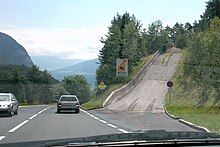Emergency lane (slope)

An emergency lane , as Notbremsweg , Bremsnotspur , flight track , snap tracking , Notweg or escape road called, one is road , which can be used in an emergency, if at a plummeting a motor vehicle due to a technical defect no longer held back can be or inexperience of the driver's Speed is out of control.
purpose
The emergency lane is used to decelerate a vehicle to a standstill. The deceleration takes place on the one hand by the ground, z. B. gravel instead, on the other hand by a slope. The most common is a combination of the two measures. Emergency lanes are used to prevent traffic accidents . Such emergency lanes can often be found on steep, long downhill stretches and are intended in particular for heavy trucks whose service brakes literally "smoke off" when approaching the downhill stretch if the speed is too high. H. run hot and, in addition to the loss of braking effect ( fading ), can also cause extreme smoke development. In modern trucks there is a combination of engine brake and retarder , which are designed as wear-free so-called continuous brakes , but this brake combination is by far not sufficient to keep the speed of the truck on slopes of more than 3-4%. With a gradient of significantly more than 5%, it can happen that the truck takes the speed of a normally driving car of 120 to 130 km / h (in extreme cases even more) and thus becomes uncontrollable.
Examples

The downhill section between the Zinnwald border crossing in the Ore Mountains on the German side and the Czech city of Teplice is 10 km long and with a gradient of 12% a dangerous downhill section in Europe. There are 3 emergency braking routes on one kilometer before Dubí ; despite the speed limit for trucks to 30 km / h, these are used relatively frequently.
After the devastating accident with a tanker truck in Herborn and another accident at the same place, the downhill section leading into the city was given a chicane that can only be driven through at a maximum of 30 km / h. Faster vehicles cannot follow the curve and are thus forcibly directed onto the existing emergency lane.
Further examples:
- Emergency lane on the BAB 7 (Germany) in a northerly direction in front of the Werra Valley Bridge in Hedemünden (see photo)
- Path that branches off: in the lowest serpentine of the Wurzenpassstrasse on the Austrian side
- Five emergency braking routes on the Zirler Berg ( B 177 in Austria ), in the upper part before the hairpin bend
- Emergency routes at the north exit of the Brenner Pass in the course of the Brenner motorway in front of Innsbruck
- Emergency lanes on the A9 Simplon Pass (Switzerland)
- Emergency lane on Bundesstraße 51 in Germany in front of the western entrance to Eicherscheid (Bad Münstereifel) after a gradient of up to 13%
- Emergency lane with a forward chicane on Bundesstraße 255 in Germany at the entrance to Herborn West.
Structure and mode of operation of the gravel bed
An emergency lane is typically filled with rolling gravel. Round stones allow the wheels of the vehicle to sink deeply due to their ease of movement and thus brake it quickly. On the other hand, angular gravel carries the vehicle, which means it is less braked.
The depth of the gravel filling should be at least 60 cm. However, since impurities in the filling material settle in the depth and impair the ability of the stones to move there, a depth of up to one meter is recommended.
See also
- Run-off zone in motorsport
- Sand track and protective switch in rail traffic
- Engineered Materials Arrestor System at airports
Web links
- Construction of an emergency lane and change of the driveway to the A45 report on the Herborn fire brigade site
- Emergency braking lanes Ramserna and Haselkehr Information on two emergency braking lanes on the A9 on the Simplon Pass in Switzerland
- Why They Have Arrester Beds Before Toll Gates Video Youtube (English)
Individual evidence
- ^ A9 Simplon | Emergency braking lanes Haselkehr Ramserna turns. Retrieved August 28, 2019 .
- ^ DOT Arizona: Full-Scale Arrester Bed Testing Leads to More Cost-Effective Design . (pdf) In: TR News . No. 166, May 1993, pp. 20-21. Retrieved July 23, 2006.
- ^ Geometric Design Professional Practice . Descending degree. In: Transportation Engineering Online Lab Manual . Archived from the original on February 4, 2012 ; accessed on June 1, 2015 .

